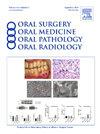粘液表皮样癌,累及表面上皮,不要与鳞状细胞癌混淆
IF 1.9
3区 医学
Q2 DENTISTRY, ORAL SURGERY & MEDICINE
Oral Surgery Oral Medicine Oral Pathology Oral Radiology
Pub Date : 2025-07-21
DOI:10.1016/j.oooo.2025.04.029
引用次数: 0
摘要
粘液表皮样癌(MEC)是世界上最常见的原发性唾液腺恶性肿瘤。MEC在组织学上可分为低、中、高级别肿瘤。当表皮样成分占主导地位时,MEC可能模仿口腔鳞状细胞癌(OSCC),这有助于诊断挑战。有必要进行细致的评估,以区分中度或高级MEC和OSCC。区分这两种实体对于预测生存和确定最合适的治疗计划是必要的。病例表现:女性,20岁,无痛性病变,持续1-2年,大小6个月无变化。临床检查显示后硬腭1.5 × 0.5 cm病变升高,中央溃疡区。切口活检显示增生的肿瘤岛的证据,其中一些连接到覆盖的表面上皮。主要由表皮样细胞组成,有分散的黏液成分。小囊性岛由黏液细胞、中间细胞和表皮样细胞排列,占肿瘤的不到20%。粘液胺和pas -淀粉酶阳性,突出显示分散的粘液细胞。肿瘤细胞p63阳性,Calponin和GATA-3阴性。结果与MEC一致,低分级。切除后,手术印象包括下骨侵蚀。切除活检显示肿瘤浸润终末导管及上覆表面上皮,囊性成分更明显。S100突出神经周围浸润。最终诊断为MEC,低分级,根据AFIP分级标准。结论mec发生于终末导管,止于表面上皮,当小切口活检以表皮样细胞为主时,可能被错误地解释为OSCC。广泛的肿瘤取样,特殊染色辅助下的细胞内粘蛋白的显示,以及中间细胞的存在,是诊断的重要线索。使用最客观的组织病理学特征对MEC进行分级,更准确地确定预后或治疗方式是很重要的。本文章由计算机程序翻译,如有差异,请以英文原文为准。
Mucoepidermoid carcinoma, involving the surface epithelium, not to be confused with OSCC
Introduction
Mucoepidermoid carcinoma (MEC) is the most common primary salivary gland malignancy worldwide. MEC can be categorized histologically into low, intermediate, and high-grade tumor. When the epidermoid component predominates, MEC may mimic oral squamous cell carcinoma (OSCC) which contribute to diagnostic challenge. Meticulous evaluation would be warranted to differentiate between moderate or high-grade MEC and OSCC. Differentiating these two entities is necessary to prognosticate survival and to determine the most appropriate treatment plan.
Case Presentation
A 20-year female presented with painless lesion, persisted for 1-2 years, and hasn’t changed in size for last 6 months. Clinical examination showed 1.5 × 0.5 cm elevated lesion of posterior hard palate with central ulcerated area. Incisional biopsy demonstrated evidence of proliferating tumor islands some of which were connected to overlying surface epithelium. That consisted of predominantly epidermoid cells, with scattered mucinous component. Small cystic islands lined by mucous, intermediate, and epidermoid cells, that contributed to less than 20% of tumor were noted. Mucicarmine and PAS-diastase positive highlighted scattered mucous cells. Tumor cells were p63 positive, and negative for Calponin and GATA-3. Findings were consistent with MEC, low grade. Upon excision, surgical impression included erosion of underlying bone. Excisional biopsy showed tumor infiltration of terminal duct and overlying surface epithelium and more prominent cystic component. S100 highlighted perineural invasion. Final diagnosis of MEC, low grade, according to AFIP classification criteria was rendered.
Conclusion
MEC arising from terminal duct ending in surface epithelium, might be erroneously interpreted as OSCC, especially when predominated with epidermoid cells on small incisional biopsies. Extensive tumor sampling, demonstration of intracellular mucin assisted by special stains, and presence of intermediate cells, represent important clue to diagnosis. It is important to use the most objective histopathologic features to grade MEC and to determine prognosis or treatment modality more accurately.
求助全文
通过发布文献求助,成功后即可免费获取论文全文。
去求助
来源期刊

Oral Surgery Oral Medicine Oral Pathology Oral Radiology
DENTISTRY, ORAL SURGERY & MEDICINE-
CiteScore
3.80
自引率
6.90%
发文量
1217
审稿时长
2-4 weeks
期刊介绍:
Oral Surgery, Oral Medicine, Oral Pathology and Oral Radiology is required reading for anyone in the fields of oral surgery, oral medicine, oral pathology, oral radiology or advanced general practice dentistry. It is the only major dental journal that provides a practical and complete overview of the medical and surgical techniques of dental practice in four areas. Topics covered include such current issues as dental implants, treatment of HIV-infected patients, and evaluation and treatment of TMJ disorders. The official publication for nine societies, the Journal is recommended for initial purchase in the Brandon Hill study, Selected List of Books and Journals for the Small Medical Library.
 求助内容:
求助内容: 应助结果提醒方式:
应助结果提醒方式:


